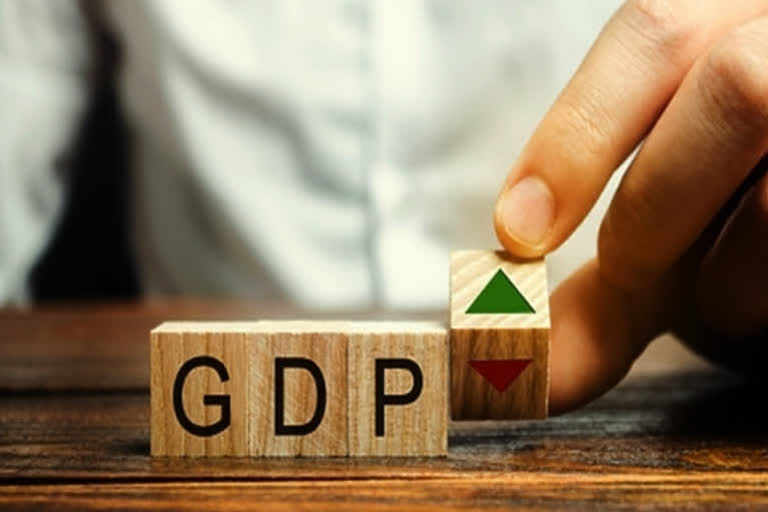New Delhi: Despite suffering the biggest contraction in GDP growth at the start of the pandemic last year, the Indian economy staged a sharp turn-around in the remaining six months of the year to join the select few economies among the G-20 nations that recorded positive growth in the last two quarters of the previous year, showed the data shared by the finance ministry.
In its monthly economic report for May 2021, the ministry described it as a V-shaped recovery as the period of economic decline, due to the imposition of a nationwide stringent lockdown in March 2020, was short-lived.
According to the provisional estimates of the country’s economic growth released by the country’s apex statistics body (NSO), India’s GDP contracted by 7.3 per cent, which was an improvement over the second advance estimate of a projected contraction of 8 per cent.
In its report, the ministry said it was largely due to the steady V-shaped recovery in India’s economy in the second half of FY 2020-21.
In its monthly report of November 2020, the ministry had stated the V-shaped recovery, evident at the halfway stage of 2020-21, reflected the resilience and robustness of the Indian economy.
India suffered biggest GDP decline
India’s GDP shrank by 24.4% in the April-June period last year, the sharpest decline among the G20 nations, which is a bloc of eight advanced and 11 major emerging economies, and the European Union.
However, with the process of gradual unlocking that started in June last year, the economy picked up the pace and the decline in GDP growth rate came down from a record -24.4% to -7.3%.
The cumulative decline in the first six months of the last fiscal was -15.9% but the economy eventually came out of two-quarters of recession and registered a positive growth of half a per cent in the third quarter (October-December period), as India’s festive season demand led to increased consumption of goods and services during the period.
The momentum was maintained in the January-March period as well as the government stepped up public expenditure on infrastructure and welfare schemes, resulting in 1.6% growth in the fourth quarter.
Public expenditure, festive demand push growth
In the second half of FY2020-21, the country recorded a 1.1% year-on-year growth against the decline of 15.9% in the first half. According to the ministry’s calculations, it implies growth of 25.5% in the second half (H2 – October to March period) over the first six months (H1 - April to September period).
Similarly, in terms of real gross value added (GVA), India’s economy registered a contraction of 6.2% in FY2020-21 with a contraction of 14.9% in the first six months of FY2020-21 and a growth of 2.4% in the second half of the fiscal.
India’s quarter-wise GDP growth showed sustained improvement after suffering a record fall of 24.4% in Q1. In the second quarter (July-September) the rate of the decline came down to 74% then in the third quarter it recorded a growth of 50 basis points and in Q4 it clocked a growth of 1.6%.
Similarly, in terms of gross value added (GVA), which adjusts taxes and subsidies included in GDP calculation, the GVA declined by 22.4% in Q1 followed by a 7.3% decline in Q2 and then it improved to 1% in Q3 and 3.7% in Q4.
“Given the large contribution of subsidies in Q3 and Q4, estimated GVA growth of 1.6 per cent in Q3 and 3.7 per cent in Q4 is more representative of economic performance in the second half of FY 2020-21,” said the ministry.
The ministry said the higher economic growth during the fourth quarter could be linked to the unlocking of the economy and revival in business and consumer confidence that was underway during the period.
Only 3 countries had positive growth in H2
According to the data compiled by the ministry, India is one of the select few economies that have witnessed positive year-on-year growth in the last two consecutive quarters.
Among the 16 major economies of the G20 group analysed by the ministry of finance, only six economies have positive economic growth in Q4, these are Canada, France, the USA, China, India and Turkey.
Only four of these, China, India, France and Turkey achieved more than 1% growth in Q4, and only three of them, China, India and Turkey recorded positive GDP growth in the last two quarters.
While the USA, UK, Germany, Japan, France, Italy, Spain and Canada are among the eight advanced economies, India, Russia, China, Brazil, South Africa, Turkey, Mexico and Indonesia are eight major emerging economies in G20.
The Finance Ministry did not use the data of three G-20 countries – Australia, Argentina and Saudi Arabia in its analysis of the economic performance of the bloc.
The G20 accounts for more than 80% of world GDP, 75% of global trade and 60% of the world population.



